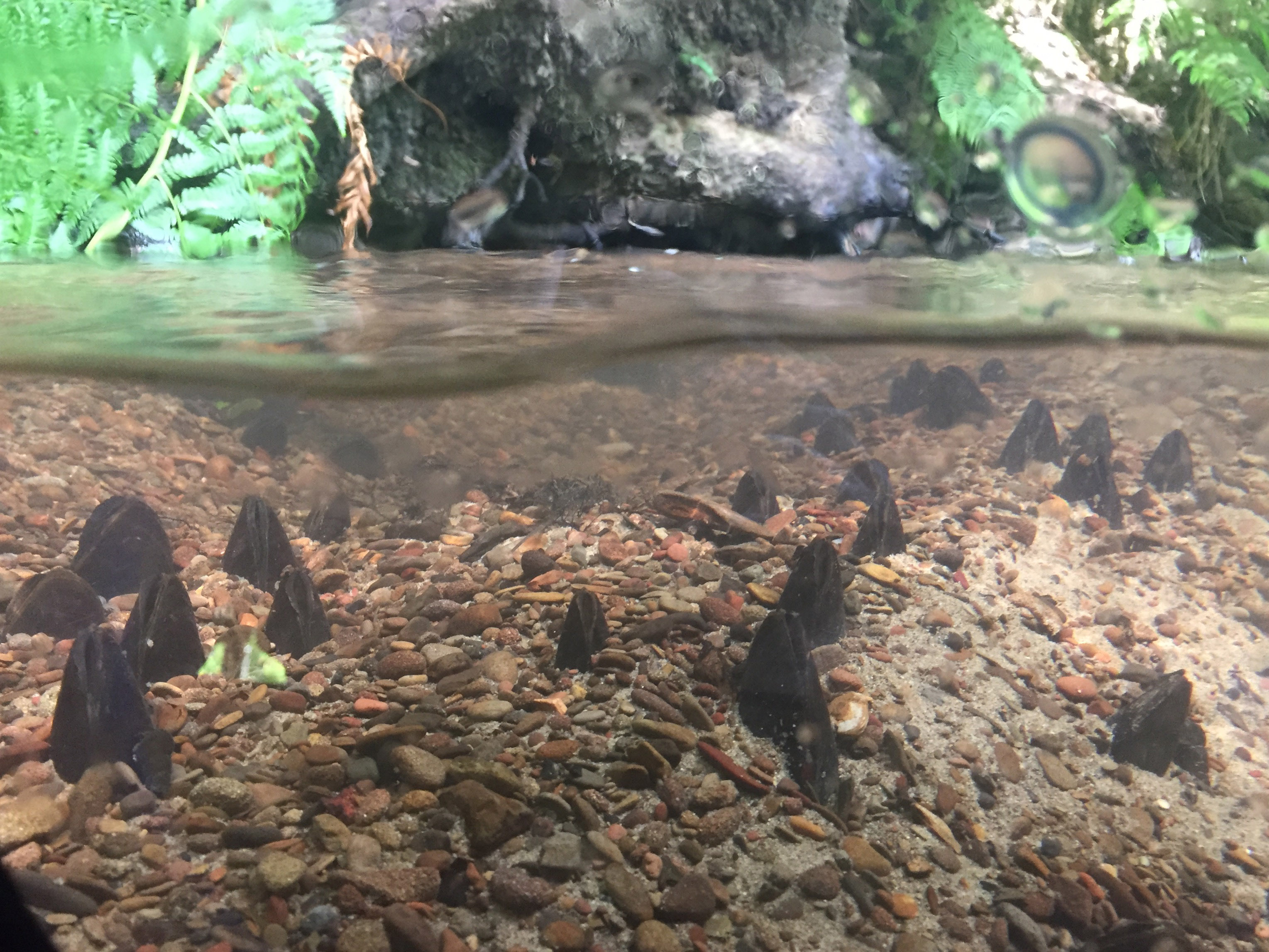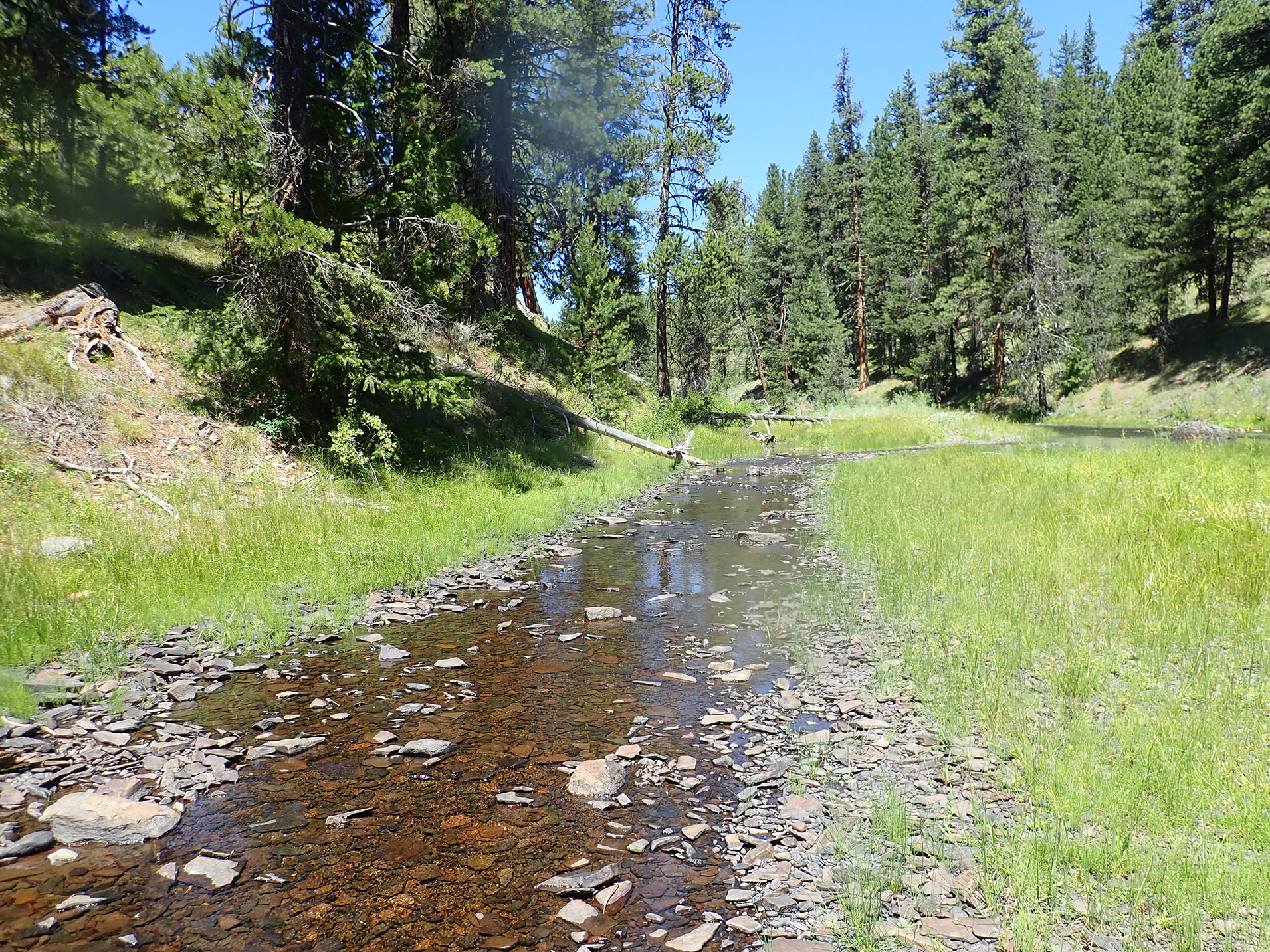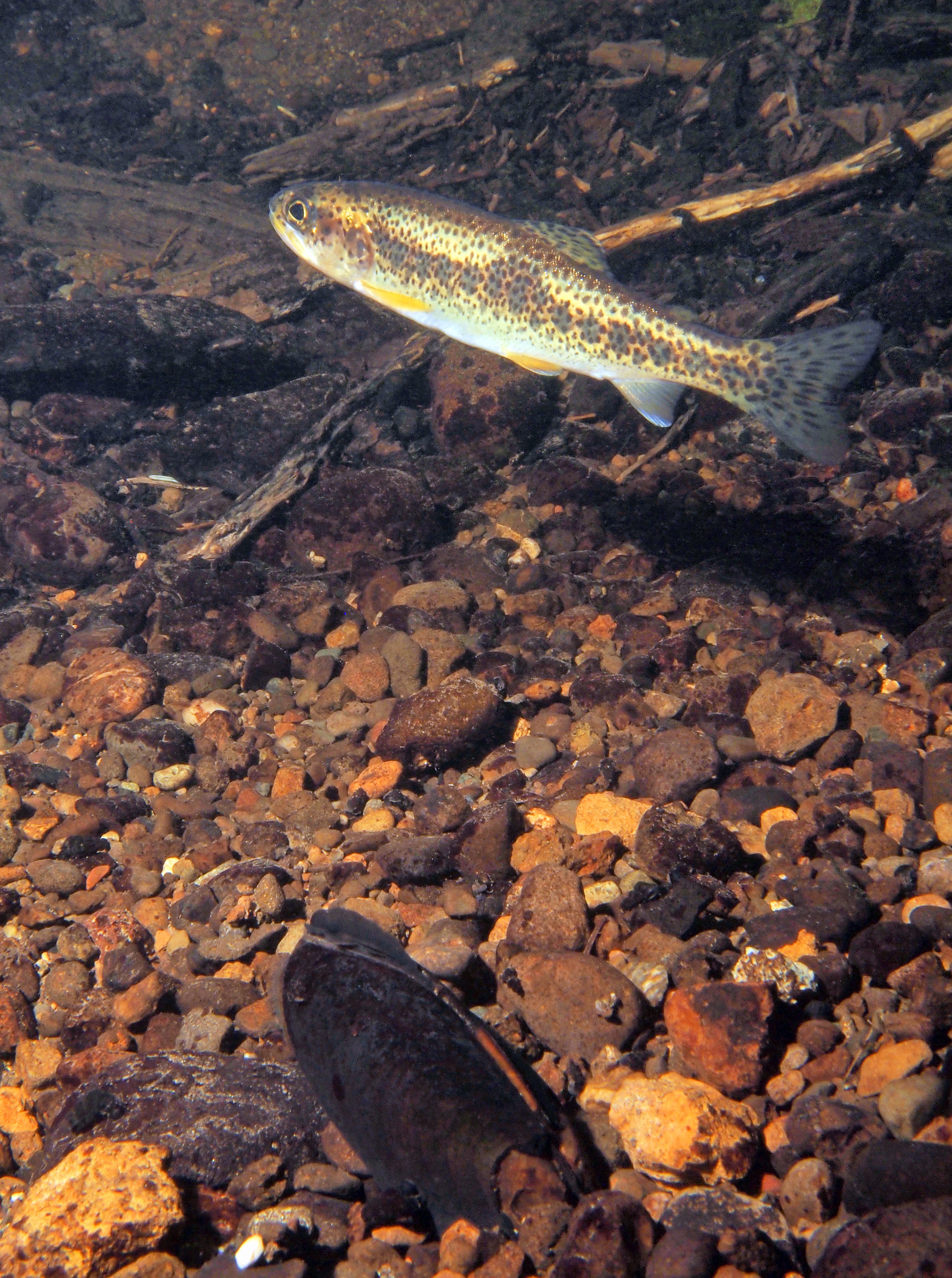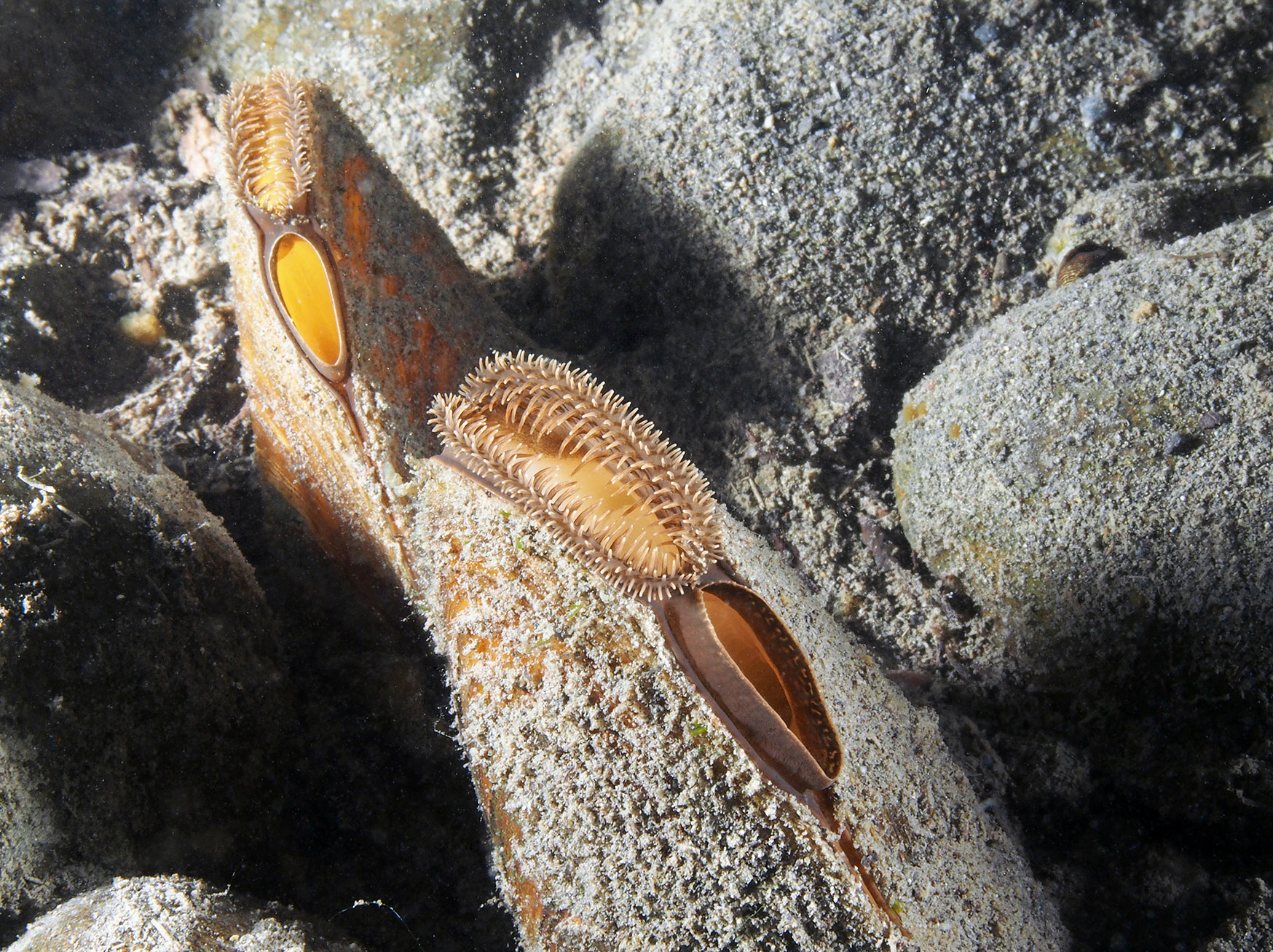Climate change is altering water flows and temperatures in creeks, impacting the freshwater mussels that are so important for water quality.
This piece originally appeared in the Fall 2018 edition of Xerces’ biannual publication Wings. Click to view the full Fall 2018 issue.
I still remember the very first mussel I ever picked up. It was a fatmucket—yes, that is its actual name—that I lifted from the bottom of North Elkhorn Creek, a tributary of the Kentucky River. The creek had been at flood stage just days before and the water was still too murky to see much of anything, but with my fingertips I could feel the animal tucked into the creek bottom.

Stepping into the creek, my goal had been to find a few freshwater mollusks—specifically, snails and mussels—for a research project in my undergraduate biology class. At the time, I knew nothing more than the most basic facts about the mussels I was studying: these bivalves burrow into the creek bottom using a muscular foot, breathe through gills, and filter oxygen and food from the flowing water. Only later would I learn about mussels’ remarkable life history—that their larvae must attach to a fish for a brief time to complete their metamorphosis into juveniles. Nor was I aware that, of the fewer than a thousand species of freshwater mussels (order Unionoida) found globally, North America was once home to almost three hundred, and the Kentucky River system, where I stood that day, to as many as sixty.
Freshwater mussels are among the estimated 150,000 species of invertebrates inhabiting freshwater ecosystems, including insects, worms, crustaceans, mollusks, and myriad other animals. Although freshwater habitats cover a minuscule portion of the Earth’s surface (less than 1 percent), they are biodiversity hotspots for vertebrates and invertebrates alike.
Water is one of our most important natural resources, and human communities depend on access to clean water to support agriculture and industry, as well as to sustain daily life. Researchers have estimated that, globally, 90 percent of the world’s population lives within six miles (ten kilometers) of a lake or river. Our reliance on water is also evident in our use and management of water bodies, with, for example, dams affecting an estimated 60 percent of large river basins worldwide. Humans have had a profound effect on freshwater ecosystems and the species that rely on them. Of these, mollusks are the most threatened, particularly freshwater mussels: about thirty North American species have already gone extinct and around two hundred more are thought to be imperiled (see the IUCN Red List for more details). In the Kentucky River system where I found the fatmucket, the number of different species of mussels has declined by nearly a third over the last century.
Conservation efforts for freshwater mussels, already challenging because of the demands upon fresh water from farming, industry, and human settlements, must now also contend with the threats posed by the warming climate. The impacts will result both from the changing environment and from our response to those changes, including our choices for managing water bodies and associated habitat.
You might wonder how climate change could affect freshwater mussels. To help answer this question, researchers have observed and evaluated how mussels respond to increasing water temperatures, decreasing river flows, drying habitat, and the increasing severity and variability of flooding events and drought—all of which are happening as a result of the warming climate and shifting patterns of precipitation.

Higher water temperatures can stress freshwater mussels by reducing their ability to burrow, which they need to be able to do in order to prevent emersion (becoming exposed to the air when water is low), escape predation, or avoid fast flows that can wash them into unsuitable habitat. High water temperatures can also affect their ability to breathe, feed, grow, and reproduce, and ultimately lead to higher rates of mortality. It can be hard to anticipate the full consequences of rising water temperatures because the upper thermal limits that most mussels can withstand are largely unknown. Complicating our understanding is the fact that not all mussels are alike, with some species better adapted than others to warmer water temperatures. Unfortunately, research led by Tamara Pandolfo of North Carolina State University suggests that water temperatures in some places may already be at or above temperatures that threaten the survival of various species of freshwater mussels.
Droughts are also expected to increase in severity, and not only do they lead to reduced streamflow and the consequent warming of water temperatures, they also contribute to lower levels of dissolved oxygen (which is critical to gill-breathing species, including fish, snails, and freshwater mussels), and the drying of habitat. Droughts are thus a major concern for freshwater mussels: researchers with the U. S. Forest Service found that a severe drought that occurred in the year 2000 in the southeastern United States led to reductions of as much as 83 percent in mussel density in small streams, with rare species among those hardest hit. Even mussel species that were common were affected when the streams in which they lived ceased flowing. In comparison, mussel communities in larger streams that maintained flow during the drought did not suffer similar losses in abundance or species.
Complicating matters further is the critical link between freshwater mussels and their host fish. Some species of mussels are generalists, and during the larval stage could use any of a number of different species of fish to complete metamorphosis. Other mussel species, in contrast, require particular fish species or species groups. Where climate change reduces the abundance of host fish, shifts their distribution, or alters the time of year when they are present, mussels that specialize on those fish will suffer consequences in future generations, and this is particularly the case for mussels that are already rare or are confined to a small range such as a single river system.

These are just some of the impacts on mussel populations and species that may be brought about by the changing climate, and this is concerning for many reasons. Freshwater mussels provide important ecosystem services to natural aquatic communities and to human populations as well, including improving water quality by removing chemical contaminants and such disease-causing organisms as E. coli bacteria. Mussels also filter and concentrate nutrients in ways that can make them available to other aquatic species throughout entire food webs, from microorganisms to aquatic insects to fish. As researchers in Oklahoma found, when freshwater mussel communities are impacted by drought and associated human decisions about water management, their ecosystem services are also diminished.
Given this potentially bleak outlook, it might be easy to forget the many ways that we can act now to conserve freshwater mussels and the ecosystems in which they live. Key to this action is management of our freshwater resources, which must be geared toward providing water for natural communities as well as human ones. This extends to both the quality and quantity of water and includes maintaining appropriate water levels, flows, and temperatures.
At an individual and community level, good management means reducing pollutant inputs as well as decreasing water consumption. (For example, you could ask yourself how green your lawn needs to be.) Other practices can also be implemented to restore freshwater ecosystems, such as removing defunct dams to reconnect aquatic habitat, and converting water rights to increase instream flows for the benefit of fish and wildlife. Now and into the future, there will be growing pressure to pump groundwater and impound or capture surface water for agricultural, industrial, and residential uses, especially during droughts. With inclusive planning we can ensure that wise water decisions are made to protect our natural heritage while supplying immediate human needs.
We are already considering the changing climate as part of our work at Xerces in conserving freshwater mussels of the western United States. Datasets are now available that predict water temperatures under future climate scenarios, provide information on existing threats to mussel resiliency (such as dams, culverts, roads across creeks, and other barriers that may limit movement and connectivity of populations), and help to inform priorities for restoration and conservation. Using this and other information—including data from the Western Freshwater Mussel Database developed by Xerces together with our partner, the Confederated Tribes of the Umatilla Indian Reservation—we are conducting an analysis to identify watersheds with the potential to serve as future climate refuges for freshwater mussels. When complete, this analysis will guide our conservation efforts toward key areas that will have the greatest benefit for western mussel species.

We have also identified other strategies to focus our conservation efforts for freshwater mussels in the western part of the continent. For example, we share location information from the mussel database with agencies and other organizations for inclusion in impact assessments, restoration or construction plans, and biological survey initiatives, to help ensure that existing mussel populations are protected. Through our recently released conservation guidelines for freshwater mussels, we provide best management practices for existing populations in western watersheds and beyond. So here’s to preserving these species for the next generation, whether in the western United States, North Elkhorn Creek, or anywhere else.
Further Reading
Read the full Fall 2018 edition of Wings Magazine.
View all of our online editions of Wings.
Learn more about Xerces’ work to protect freshwater mussels.




